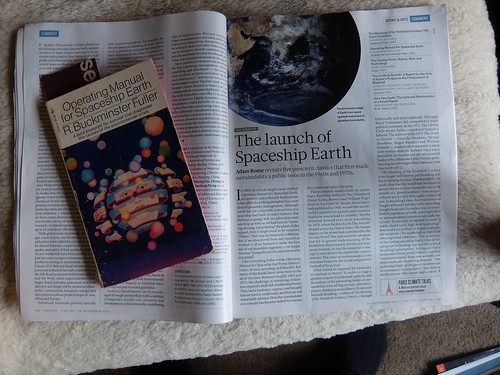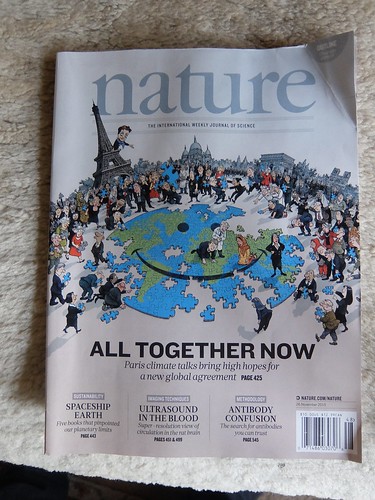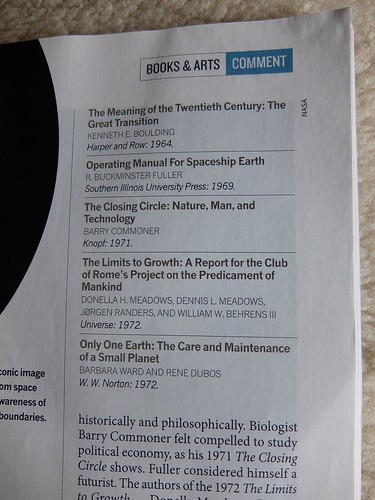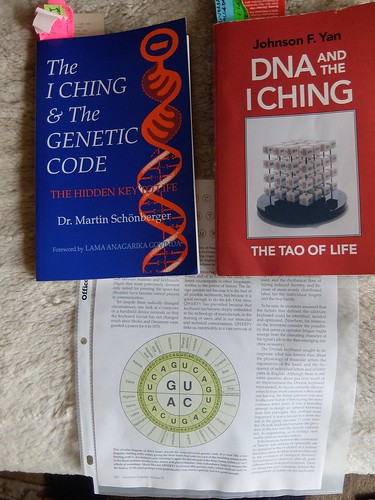Glenn and I have much in common. He has Global Matrix, I have Global Data. Both are rubrics of some kind. He sees Global Matrix as a technology which the Institute for Integral Design would share.
What's Global Matrix? It has to do with spherical shells for a "Z axis" and hexapents for each of the concentric layers. One could show not only the Earth's surface, but beneath the surface characteristics. Showing MRI-like cross-sections of neurons would be another application of an hexagonally pixelated display.
At lunch today Glenn shared the latest of issue of Nature. E.J. Applewhite would have been pleased about it I think as Fuller's Operating Manual for Spaceship Earth is given top billing and is included on Adam Rome's short list of five influential tomes on sustainability, all from the same time period, late 1960s, early 1970s. Applewhite always saw Nature as the gold standard, when it came to acceptability within the sciences.
Another of those tomes is by Kenneth Boulding, the Quaker systems theorist. General Systems Theory overlaps with economics. He's sometimes called an economist.
The GUAC chart (those are the four bases of RNA, with U replaced by T in DNA), in American Scientist (vol 97.) showing how to get the 20 amino acids from 64 combinations of GUAC (4 x 4 x 4) is plenty instructive. The sixty-four trigrams of the I-Ching, isomorphic to the sixty-four possibilities depicted, figure into Glenn's Global Matrix for sure.
The literature mapping sixty-four hexagrams to DNA sequences is fairly well developed -- the same permutations of four possibilities is at work in both. Glenn's background in applied cryptography (NSA / Vietnam) gives him a nose for, an appreciation for, such literature. "Connecting the dots" is the name of the game.
What's Global Matrix? It has to do with spherical shells for a "Z axis" and hexapents for each of the concentric layers. One could show not only the Earth's surface, but beneath the surface characteristics. Showing MRI-like cross-sections of neurons would be another application of an hexagonally pixelated display.
At lunch today Glenn shared the latest of issue of Nature. E.J. Applewhite would have been pleased about it I think as Fuller's Operating Manual for Spaceship Earth is given top billing and is included on Adam Rome's short list of five influential tomes on sustainability, all from the same time period, late 1960s, early 1970s. Applewhite always saw Nature as the gold standard, when it came to acceptability within the sciences.
Another of those tomes is by Kenneth Boulding, the Quaker systems theorist. General Systems Theory overlaps with economics. He's sometimes called an economist.
The GUAC chart (those are the four bases of RNA, with U replaced by T in DNA), in American Scientist (vol 97.) showing how to get the 20 amino acids from 64 combinations of GUAC (4 x 4 x 4) is plenty instructive. The sixty-four trigrams of the I-Ching, isomorphic to the sixty-four possibilities depicted, figure into Glenn's Global Matrix for sure.
The literature mapping sixty-four hexagrams to DNA sequences is fairly well developed -- the same permutations of four possibilities is at work in both. Glenn's background in applied cryptography (NSA / Vietnam) gives him a nose for, an appreciation for, such literature. "Connecting the dots" is the name of the game.




